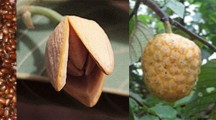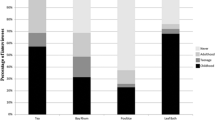Ethnobotanical Remedies for Acute Diarrhea in Central Anatolian Villages. Acute gastrointestinal illness is a common, life–threatening complication for rural villagers in developing countries such as Turkey. Our study identifies and describes the classification schemes surrounding acute gastrointestinal illness, or diarrhea, and its folk treatments among Central Anatolian villagers. We conducted informal interviews with small groups of rural Turkish villagers in the spring of 2009, using scenarios, recall, free–listing, and ranked saliency techniques to amass information on knowledge and beliefs about diarrhea and its treatments. We also compared treatments from published ethnobotanical studies with 8 of 44 plants still used today. Foods available in the home as well as nearby wild plants were used by 96% of villagers to treat diarrhea. Species in the Rosaceae, Lamiaceae, and Asteraceae families were used most frequently. Villagers blended folk and biomedical concepts to explain their preferences for botanical remedies and to explain the perceived treatment efficacy.
Orta Anadolu Köylerinde Akut İshal için Etnobotanik Tedaviler. Akut gastrointestinal hastalık Türkiye gibi gelişmekte olan ülkelerde kırsal alanda yaşayan köylüler için yaygın ve hayatı tehdit eden bir komplikasyonudur. Çalışmamızda akut gastrointestinal hastalık ya da ishalin Orta Anadolu köylüleri arasında geleneksel tıbbi yöntemler kullanılarak yapılan tedavi biçimleri sınıflandırılmış ve tanımlanmıştır. Çalışma kapsamında 2009 yılı baharında, ishal ve ishal tedavileri hakkında inanç ve bilgileri toplamak için anımsatma, yeniden yapılandırma, serbest listeleme, yöntemleriyle gayriresmi sınırlı grup görüşmeler yürütülmüştür. Ayrıca etnobotonikal çalışmalarda basılı olan ve bugün halıhazırda kullanılan 44 bitkiden sekiz tanesi de karşılaştırılmıştır. Evde kullanılan yiyeceklerin yanı sıra civardaki yabani otlar da köylülerin %96’sı tarafından ishali tedavi amaçlı kullanılmaktadır. En sık kullanılan türler arasında gülgiller, ballıbabagiller, papatyagiller bulunmaktadır. Köylüler uyguladıkları bitkisel tedavinin iyileştirici etkisini açıklamak için geleneksel ve biyomedikal tedavi türlerini harmanlamaktadırlar.

Similar content being viewed by others
Literature Cited
Agunua, A., S. Yusuf, G. O. Andrew, A. U. Zezi, and E. M. Abdurahman. 2005. Evaluation of five medicinal plants used in diarrhoea treatment in Nigeria. Journal of Ethnopharmacology 101:27–30.
Alexiades, M. 1996. Selected guidelines for ethnobotanical research: A field manual. The New York Botanical Garden Press, Bronx, NY.
APG III. 2009. An update of the Angiosperm Phylogeny Group classification for the orders and families of flowering plants: APG III. Botanical Journal of the Linnean Society 161:105–121.
Atalay, I. 2002. Coğrafya Atlasi. Inkilap Kitabevi, Istanbul.
Berlin, E. and B. Berlin. 1996. Medical ethnobiology of the highland Maya of Chiapas, Mexico: The gastrointestinal diseases. Princeton University Press, Princeton, New Jersey.
Davis, P. H., ed. 1965–1985. Flora of Turkey and the East Aegean Islands. Vols. 1–9. Edinburgh: Edinburgh University Press.
____, K. Tan, and R. R. Mill, eds. 1988. Flora of Turkey and the East Aegean Islands. Vol. 10. Edinburgh: Edinburgh University Press.
Dole, C. 2004. In the shadows of medicine and modernity: Medical integration and secular histories of religious healing in Turkey. Culture, Medicine and Psychiatry 28:255–280.
Ergener, R. 2002. About Turkey: Geography, economy, politics, religion, and culture. Pilgrims’ Process, Inc., Boulder, CO.
Ertuğ, F. 2000. An ethnobotanical study in Central Anatolia (Turkey). Economic Botany 54:155–182.
Eyüboğlu, I. Z. 1987. Anadolu Halk Ilaçları. Gecit Kitabevi, Istanbul.
Fawole, O. A., A. R. Ndhlala, S. O. Amoo, J. F. Finnie, and J. Van Staden. 2009. Anti–inflammatory and phytochemical properties of twelve medicinal plants used for treating gastro–intestinal ailments in South Africa. Journal of Ethnopharmacology 123:237–243.
Fujita, T., E. Sezik, M. Tabata, E. Yeşilada, G. Honda, and Y. Takeda. 1995. Traditional medicine in Turkey VII. Folk medicine in middle and west Black Sea regions. Economic Botany 49:406–422.
Güner, A., N. Özhatay, T. Ekim, and K. H. C. Başer, eds. 2000. Flora of Turkey and the East Aegean Islands, Vol. 11. Edinburgh University Press, Edinburgh.
Heinrich, M., H. Rimpler, and N. A. Barrera. 1992. Indigenous phytotherapy of gastrointestinal disorders in Lowland Mixe Community (Oaxaca, Mexico): Ethnopharmacologic evaluation. Journal of Ethnopharmacology 36:63–80.
Honda, G., Y. Takeda, T. Tanaka, Y. Takaishi, E. Sezik, and E. Yeşilada. 1996a. A report on traditional medicines and medicinal plants in Turkey (1994). Faculty of Pharmaceutical Sciences, Kyoto University, Kyoto, Japan.
____, Y. Takoda, T. Tanaka, Y. Takaishi, E. Sezik, and E. Yeşilada. 1988. A report on traditional medicine and medicinal plants in Turkey (1986). Kyoto, Japan: Faculty of Pharmaceutical Sciences, Kyoto University.
———, E. Yeşilada, M. Tabata, E. Sezik, T. Fujita, and Y. Takeda. 1996b. Traditional medicine in Turkey VI. Folk medicine in West Anatolia: Afyon, Kütahya, Denizli, Muğla, Aydın Provinces. Journal of Ethnopharmacology 53:75–87.
Kaya, Z. and D. Raynal. 2001. Biodiversity and conservation of Turkish forests. Biological Conservation 97:131–141.
Kusova, R. D., A. L. Kazakov, and M. S. Luk’yanchikov. 1988. Phenolic compounds from fruit of Elaeagnus angustifolia. Chemistry of Natural Compounds 24(3):392–393.
Lewis, W. and M. Elvin-Lewis. 2003. Medical botany: Plants affecting human health. John Wiley Interscience, New York.
Mathabe, M. C., R. V. Nikolova, N. Lall, and N. Z. Nyazema. 2006. Antibacterial activities of medicinal plants used for the treatment of diarrhoea in Limpopo Province, South Africa. Journal of Ethnopharmacology 105:286–293.
Nolan, J. 2001. Pursuing the fruits of knowledge: Cognitive ethnobotany in Missouri’s Little Dixie. Journal of Ethnobiology 21(2):29–50.
Olson, D. M., E. Dinerstein, E. D. Wikramanaya, N. D. Burgess, G. V. N. Powell, E. C. Underwood, J. A. D’Amico, I. Itoua, H. E. Strand, J. C. Morrison, C. J. Loucks, T. F. Allnutt, T. H. Ricketts, Y. Kura, J. F. Lamoreux, W. W. Wettengel, P. Hedao, and K. R. Kassem. 2001. Terrestrial ecoregions of the world: A new map of life on Earth. BioScience 51(11):933–938.
Özgökçe, F. and H. Özçelik. 2004. Ethnobotanical aspects of some taxa in East Anatolia, Turkey. Economic Botany 58:697–704.
PCD (The Partnership of Child Development). 2000. What’s new in health & nutrition of the school–age child and in school health and nutrition programmes? Part. Child. Dev. 1–46.
Peel, M. C., B. L. Finlayson, and T. A. McMahon. 2007. Updated world map of the Köppen–Geiger Climate Classification. Hydrology and Earth System Sciences 11:1633–1644.
Qiao, H., J. Yang, X. Yang, L. Zhao, and T. Li. 2011. GC–MS Analysis of chemical composition of volatile oil from flowers of Elaeagnus angustifolia L. 食品科学 (Alimentary Science) 32(16): 233–235 (in Chinese)
Quinlan, M. B. 2010. Ethnomedicine and ethnobotany of fright, a Caribbean culture–bound psychiatric syndrome. Journal of Ethnobiology and Ethnomedicine 6:1–18.
Šavikin, K., G. Zdunić, T. Janković, T. Stanojković, Z. Juranić, and N. Menković. 2009. In vitro cytotoxic and antioxidative activity of Cornus mas and Cotinus coggygria. Natural Products Research 23(18):1731–1739.
Şenol, S., Ö. Seçmen, and E. Uğurlu. 2006. Some ethnobotanical uses in the rural areas of Ödemiş, Tire, Kiraz (İzmir–Turkey). In: Proceedings of the Fourth International Congress of Ethnobotany (ICEB 2005), ed., F. Ertuğ, 605–608. Istanbul: Yeditepe University Press.
Sezik, E., M. Tabata, E. Yeşilada, G. Honda, K. Goto, and Y. Ikeshiro. 1991. Traditional medicine in Turkey I. Folk medicine in North–east Anatolia. Journal of Ethnopharmacology 35:191–196.
____, E. Yeşilada, G. Honda, Y. Takaishi, Y. Takeda, and T. Tanaka. 2001. Traditional medicine in Turkey X. Folk medicine in Central Anatolia. Journal of Ethnopharmacology 75:95–115.
———, ———, M. Tabata, G. Honda, Y. Takaishi, and T. Fujita. 1997. Traditional medicine in Turkey VIII. Folk medicine in East Anatolia. Economic Botany 51:195–211.
———, M. Zor, and E. Yeşilada. 1992. Traditional medicine in Turkey II. Folk medicine in Kastamonu. International Journal of Pharmacognosy 30:233–239.
Si C.–L., P.–P. Qin, Y.–Y. Lu, L. Wu, H.-H. Wang, L.–F. Hui, Z. Liu, and Y. Ni. 2011. GC–MS analysis of chemical composition and free radical scavenging activity of Elaeagnus angustifolia bark. Advanced Materials Research 183–185:854–858.
Simeon, D. T. and S. Grantham–McGregor. 1990. Nutritional deficiencies and children behaviour and mental development. Nutritional Research Review 3:1–24.
Şimşek, I., F. Aytekin, E. Yeşilada, and Ş. Yıldırımlı. 2004. An ethnobotanical survey of the Beypazarı, Ayas, and Güdül district towns of Ankara Province (Turkey). Economic Botany 58:795–720.
Stevens, P. F. 2001 onwards. Angiosperm Phylogeny Website. St. Louis, Missouri: Missouri Botanical Garden. Version 9, June 2008. http://www.mobot.org/MOBOT/research/APweb/ (12–20 April 2011).
Tabata, M., G. Honda, and E. Sezik. 1988. A report on traditional and medicinal plants in Turkey (1986). Faculty of Pharmaceutical Sciences, Kyoto University, Kyoto, Japan and Ankara, Turkey.
____, G. Honda, E. Sezik, and E. Yeşilada. 1993. A report on traditional medicine and medicinal plants in Turkey (1990, 1991). Kyoto, Japan: Faculty of Pharmaceutical Sciences, Kyoto University.
———, E. Sezik, G. Honda, E. Yeşilada, K. Goto, and Y. Ikeshiro. 1994. Traditional medicine in Turkey III. Folk medicine in East Anatolia; Van and Bitlis Provinces. International Journal of Pharmacognosy 32:3–12.
Tetali, P., C. Waghchaure, P. G. Daswani, N. H. Antia, and T. J. Birdi. 2009. Ethnobotanical survey of antidiarrhoeal plants of Parinche Valley, Pune District, Maharashtra, India. Journal of Ethnopharmacology 123:229–236.
The Ministry of Health of Turkey. 2004. Turkey health report. Ankara, Turkey: The Ministry of Health of Turkey (Türkiye Cumhuriyeti Sağlık Bakanlığı) and The School of Public Health (Refik Saydam Hıfzıssıhha Mektebi Müdürlüğü).
Turkish Ministry of the Interior. 2010. Address based population registration system population census results, 2009. Turkish Statistical Institute, Prime Ministry (Türkiye Cumhuriyeti İçişleri Bakanlığı). http://www.turkstat.gov.tr/PreHaberBultenleri.do?id=6178 (15 February 2011).
Tuzlacı, E. and D. F. Alparslan. 2007. Turkish folk medicinal plants, part V. Babaeski (Kırklareli). Journal of Istanbul University Faculty of Pharmacy 39:11–23.
____ and P. Aymaz. 2001. Turkish folk medicinal plants, part IV: Gönen (Balıkesir). Fitoterapia 72:323–343.
——— and G. (Emre) Bulut. 2007. Turkish folk medicinal plants, part VII: Ezine (Çanakkale). Journal of Istanbul University Faculty of Pharmacy 39:39–56.
——— and E. Sadikoğlu. 2007. Turkish folk medicinal plants, part VI: Koçarlı (Aydın). Journal of Istanbul University Faculty of Pharmacy 39:25–37.
——— and E. Tolon. 2000. Turkish folk medicinal plants, part III: Sile (Istanbul). Fitoterapia 71:673–685.
Ulukanlığıl, M. and A. Seyrek. 2004. Anthropometric status, anaemia and intestinal helminthic infections in shantytown and apartment schoolchildren in the Sanliurfa province of Turkey. European Journal of Clinical Nutrition 58:1056–1061.
WHO and UNICEF. 2004. Clinical management of acute diarrhoea. WHO/FCH/CAH/04.7. World Health Organization and United Nations’ Children’s Fund, Geneva.
Yeşilada, E., G. Honda, E. Sezik, M. Tabata, T. Fujita, and T. Tanaka. 1995. Traditional medicine in Turkey. V. Folk Medicine in the inner Taurus Mountains. Journal of Ethnopharmacology 46:133–152.
____, G. Honda, E. Sezik, M. Tabata, K. Goto, and Y. Ikeshiro. 1993. Traditional medicine in Turkey IV. Folk medicine in the Mediterranean subdivision. Journal of Ethnopharmacology 39:31–38.
———, E. Sezik, G. Honda, Y. Takaishi, Y. Takeda, and T. Tanaka. 1999. Traditional medicine in Turkey IX: Folk medicine in north–west Anatolia. Journal of Ethnopharmacology 64:195–210.
Acknowledgments
Research was funded through a J. William Fulbright Fellowship to Rose, and sponsorship was given by Gazi University through the Pharmacognosy Faculty by İlhan Gürbüz and Ekrem Sezik. Taxonomic experts Zeki Aytaç and Ufuk Özbek from the Botany Department at Gazi University assisted in some species identifications. Sema Demir of the Department of Turkish Folklore helped administer surveys and collect data. At FIU, Rose was funded by NIH NIGMS R25 GM 061347 and an Agroecology grant.
Author information
Authors and Affiliations
Corresponding author
Electronic Supplementary Material
Below is the link to the electronic supplementary material.
ESM 1
(DOC 211 kb)
Rights and permissions
About this article
Cite this article
Rose, J.L., Özünel, E.Ö. & Bennett, B.C. Ethnobotanical Remedies for Acute Diarrhea in Central Anatolian Villages. Econ Bot 67, 137–146 (2013). https://doi.org/10.1007/s12231-013-9233-8
Received:
Accepted:
Published:
Issue Date:
DOI: https://doi.org/10.1007/s12231-013-9233-8




